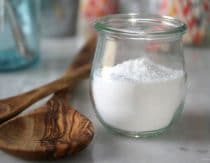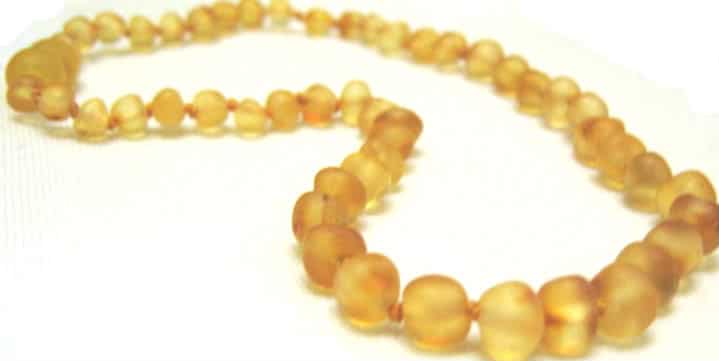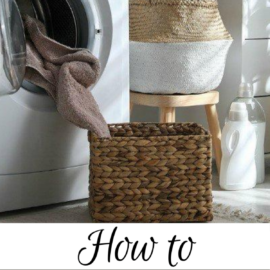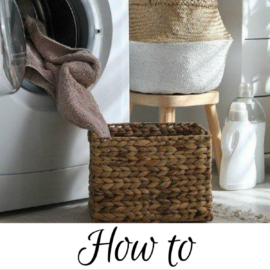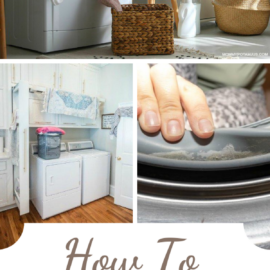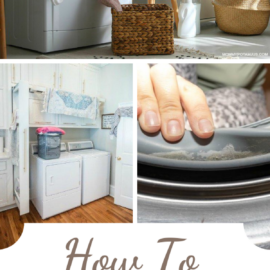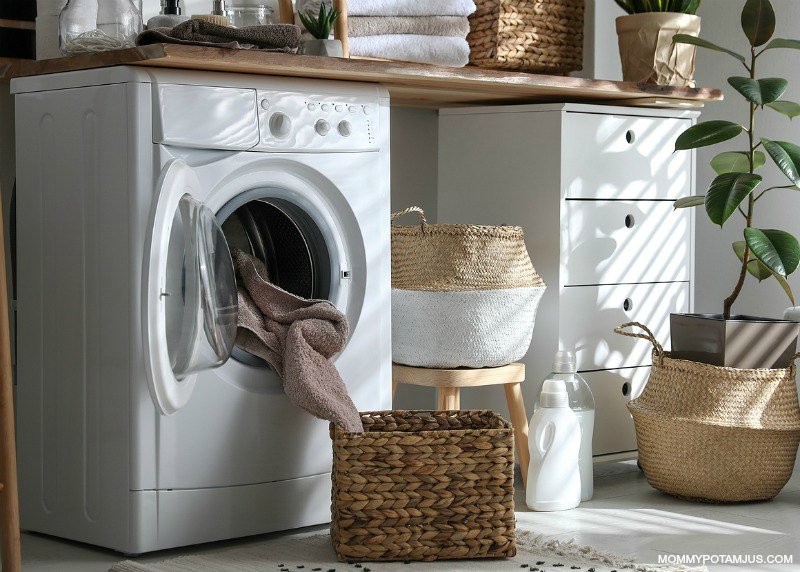
I used to think that washing machines were self-cleaning: Just toss in your dirty clothes, a scoop or two of laundry detergent, and the machine cleans the clothes AND itself, right?
Unfortunately, no.
Just like bathtubs, washing machines can develop buildup from soap scum and hard-water deposits. The dirt and funk in our clothes has to go somewhere, too, and unfortunately it likes to stick to any buildup that is present.
Washing machines are also vulnerable to mold and mildew – which can be transferred to clothes and indoor air – often in places we can’t easily see.
So, if you’ve ever had a load of clothes come out of the wash smelling funkier than they went in, it may be time to give it a good cleaning.
We’ll cover how to clean your washing machine below, plus additional tips for keeping it clean longer. But first, you might be wondering . . .
How often should I clean my washing machine?
Recommendations can vary based on how many loads of laundry you do each week, how humid your environment is, and how hard your water is. In general, a top-loading washer should be cleaned between every three to six months. That said, if you notice that your clothes are not smelling as fresh as usual or just want to clean it more frequently, that’s okay, too.
Front-loaders typically need to be cleaned more often due to the likelihood of mildew developing in the rubber seal near the door – monthly is the typical recommendation.
Here’s What You’ll Need To Get Started
The ingredients listed below are recommended by places like Home Depot, and they know a thing or two about appliances. However, you’ll want to check your manufacturer’s instruction – in some cases, they require the use of a specific product (or products) in order to keep the warranty valid.
Vinegar
First up is an ingredient that many people avoid because they’ve been told it can break down rubber seals. My appliance manufacturer actually recommends it, and so do a lot of other manufacturers when running a self-clean cycle. (You’ll want to check with yours to be sure, though.)
When mixed with hot water, white vinegar can act as a deodorizer (great for mildew), degreaser, and descaler (buildup remover). I like to use my homemade cleaning vinegar – which is infused with citrus peels – in my top loader. I wouldn’t use it on the rubber seal found on front-loaders, though, because the citrus essential oils could break down the rubber.
Washing Soda or Baking Soda
Baking soda is often recommended to help clear away any deposits that have been loosened up by the hot water and vinegar. Personally I prefer washing soda because it has a pH of around 11 vs baking soda which is around 8. In other words it’s more powerful, which is why it’s used in some commercial laundry detergents and baking soda isn’t.
That said, you can totally use baking soda . . . you’ll just need to use more to raise the pH enough to help rinse away grease, grime, mold and mineral deposits.
Other Supplies
- Clean cloths for wiping out the washer drum
- Toothbrush for hard-to-reach nooks and crannies (May or may not be needed depending on your machine)
- Oxygen bleach (optional – adds cleaning power to the washing soda cycle)
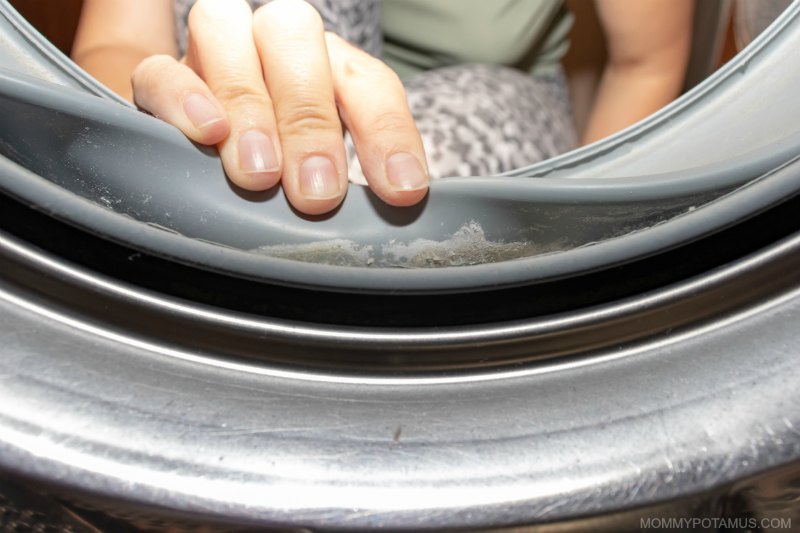
How To Clean A Front-Loading Washing Machine
You’ll need:
- 2 cups white vinegar
- 4 tablespoons washing soda OR 2 tbsp washing soda + 2 tbsp oxygen bleach OR 1/2 cup baking soda
Step-by-Step Instructions:
1. Clean the gasket (rubber seal) around the door by spraying it with white vinegar, letting it sit for at least a minute, then wiping any gunk, grime, lint or mildew away with a clean cloth. Repeat if necessary until the cloth stays clean after you wipe it on the gasket.
2. Use an old toothbrush to scrub the fabric softener and detergent dispensers. If they’re removable, you can soak them in vinegar, then rinse, dry, and put them back before going to the next step.
3. Add two cups of white cleaning vinegar to detergent dispenser and run it through a cycle on the hottest water setting and the largest load capacity possible. (Ignore that last part if a sensor selects load size for you.)
4. While the cycle is going, wipe down the exterior of the washing machine with a damp cloth.
5. Sprinkle washing soda (with or without oxygen bleach) or baking soda into the washer drum and run another full cycle with hot water.
6. When the cycle is done, wipe down the inside washer drum with a clean cloth.

How To Clean A Top Loading Washing Machine
You’ll need:
- 1 quart of white vinegar
- 1/2 cup washing soda OR 1/4 cup washing soda + 1/4 cup oxygen bleach OR 1 cup baking soda
Step-by-Step Instructions:
1. Set your washing machine to the hottest water setting and the largest load capacity and allow it to fill up.
2. Add the quart of white vinegar and let the agitator run for a minute or so to mix it in.
3. Lift the lid to pause the cycle and let the vinegar soak for 30-60 minutes. Some models will continue to run if you lift the lid, so take whatever step is needed for your machine to pause and soak.
4. If the top of your agitator (aka the fabric softener dispenser) is removable, you can take it off and place it in the washer drum to soak in the vinegar mixture.
4. While the washer drum is soaking, wipe down the exterior of the washing machine with a damp cloth. (You can dip your cloth in the hot vinegar water if desired.)
5. After the hot vinegar water soak is complete, put the agitator back on (if needed) and resume the cycle and allow it to complete.
6. When the cycle is done, repeat steps 1-5 using washing soda (with or without oxygen bleach) or baking soda instead of vinegar. The only difference with this cycle is that you don’t need to soak the fabric softener dispenser because it’s already clean.
7. When the cycle is done, wipe down the inside washer drum with a clean cloth.
5 Tips To Keep Your Washing Machine Fresh Longer
1. Remove clean clothes promptly after a cycle. Don’t let them stay in there and create an environment for mold and mildew.
2. If you can do it safely, leave the lid open or washing machine door ajar. Mold thrives in damp places, so if possible leave the lid/door open to allow air to circulate and dry out the washer drum. Some front loaders have a latch that keeps the door cracked so that it can dry out, and there are after-market products that do the same thing if not. This one has good reviews and fits most washers, but has some small magnets inside that could be a choking hazard for small children.
On that note, keep small children (who might climb inside) and pets away from an open machine, and if that’s not possible skip this tip. Safety first, always.
3. Swap fabric softener for wool dryer balls. While a few fabric softeners get a “B” from the Environmental Working Group, the majority get a “D” or “F” in terms of safety. That’s not the only problem, though – they tend to leave a residue that serves as a breeding ground for mold and mildew. Wool dryer balls are a great alternative that soften and fluff clothes while reducing drying time.
Here’s how to make them and here’s what to buy if you don’t want to DIY.
4. If you have a high efficiency front-loader, gently wipe the rubber gasket with a clean cloth after each wash. Keeping that area dry will go a long way toward preventing mold and mildew.
5. Don’t overuse detergent. It can cause excess buildup.
Troubleshooting
If after cleaning your washing machine you’re still noticing an odor, try cleaning the filter and checking the hoses according to your manufacturer’s instructions. If that doesn’t work, try contacting the manufacturer.
How To Clean Your Washing Machine
Equipment
- clean cloth
Ingredients
- white vinegar
- washing soda or baking soda (oxygen bleach is an optional addition)
Instructions
- Use vinegar and a clean cloth to clean rubber seals and fabric softener/detergent dispensers.
- Set your washing machine to the hottest water setting and the largest load capacity and run a load with vinegar (no clothes).
- Set your washing machine to the hottest water setting and the largest load capacity and run a load with washing soda (and powdered oxygen bleach if desired) or baking soda.
- When the cycle is done, wipe down the inside washer drum with a clean cloth. If desired, wipe down the exterior with a damp cloth.
Want a FREE ebook of non-toxic cleaning recipes that WORK?
I’ve created a free ebook for you as a gift for signing up for my newsletter. 7 Non-Toxic Cleaning Recipes That Really Work covers seven recipes that you can make in just a few minutes each for squeaky clean windows, sparkling dinnerware, lemon-fresh countertops, and more. Subscribe to my newsletter below and you’ll be redirected to a download page for immediate access to this PDF ebook.
If you try this method, leave me a comment below and let me know how it went!



